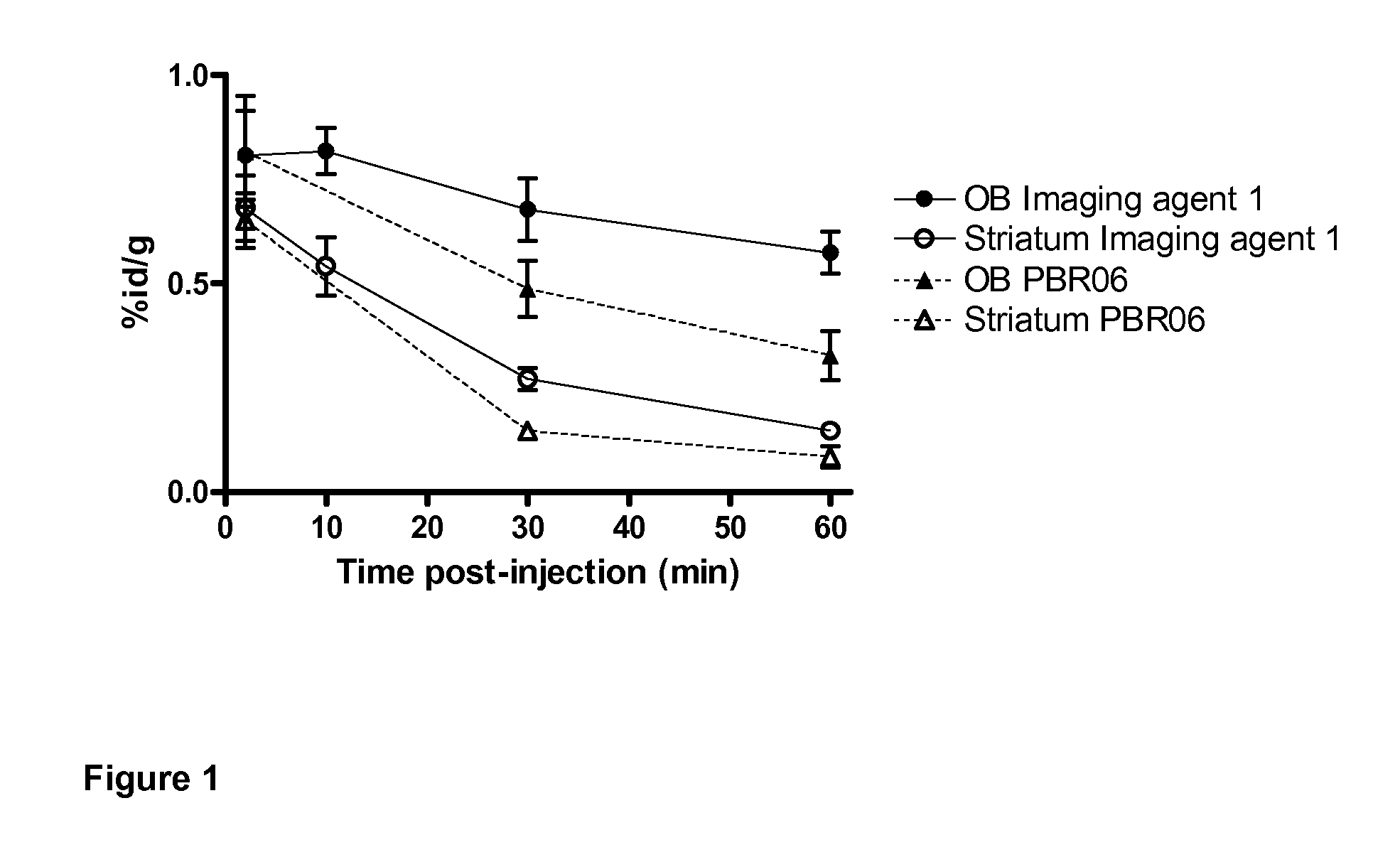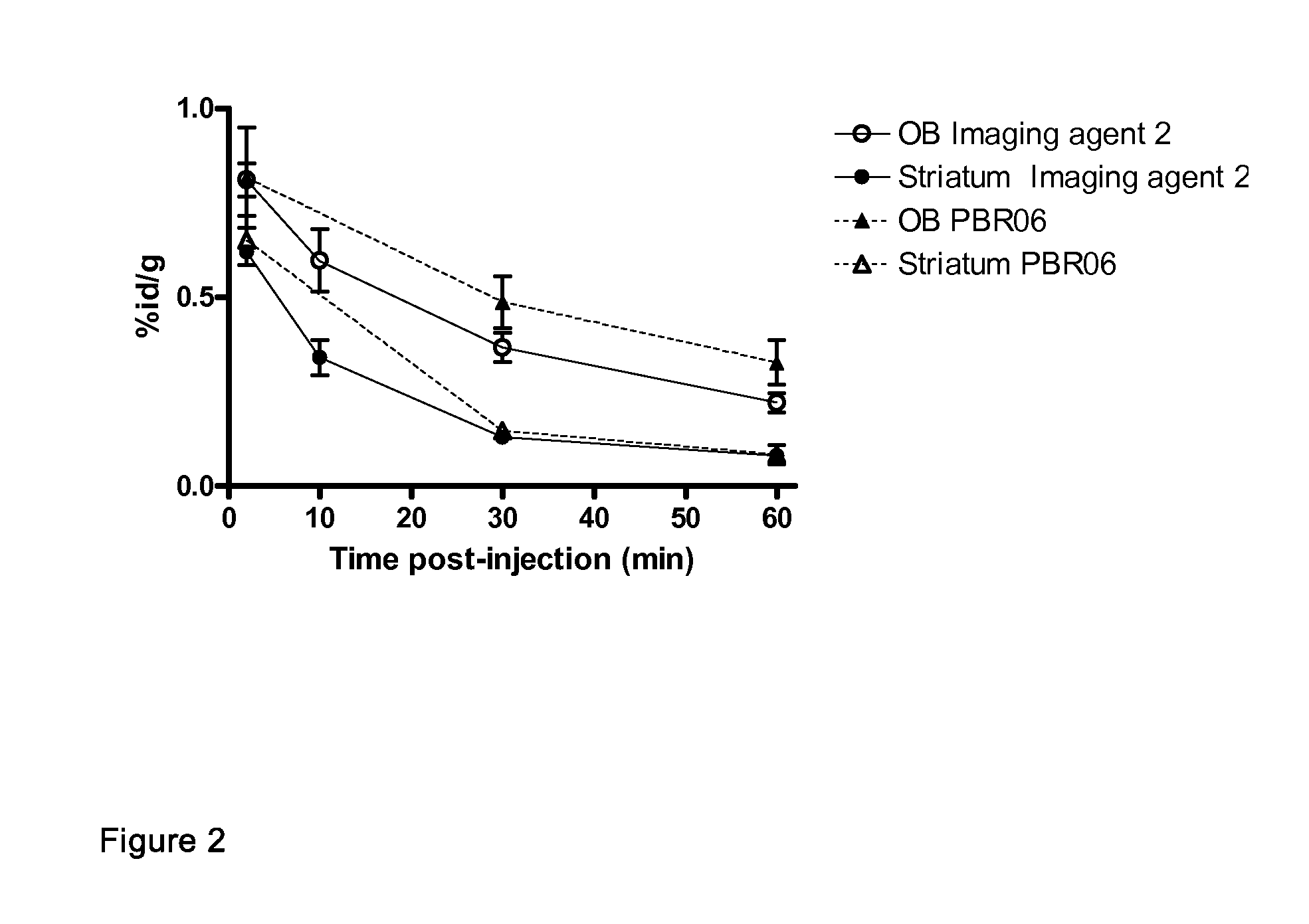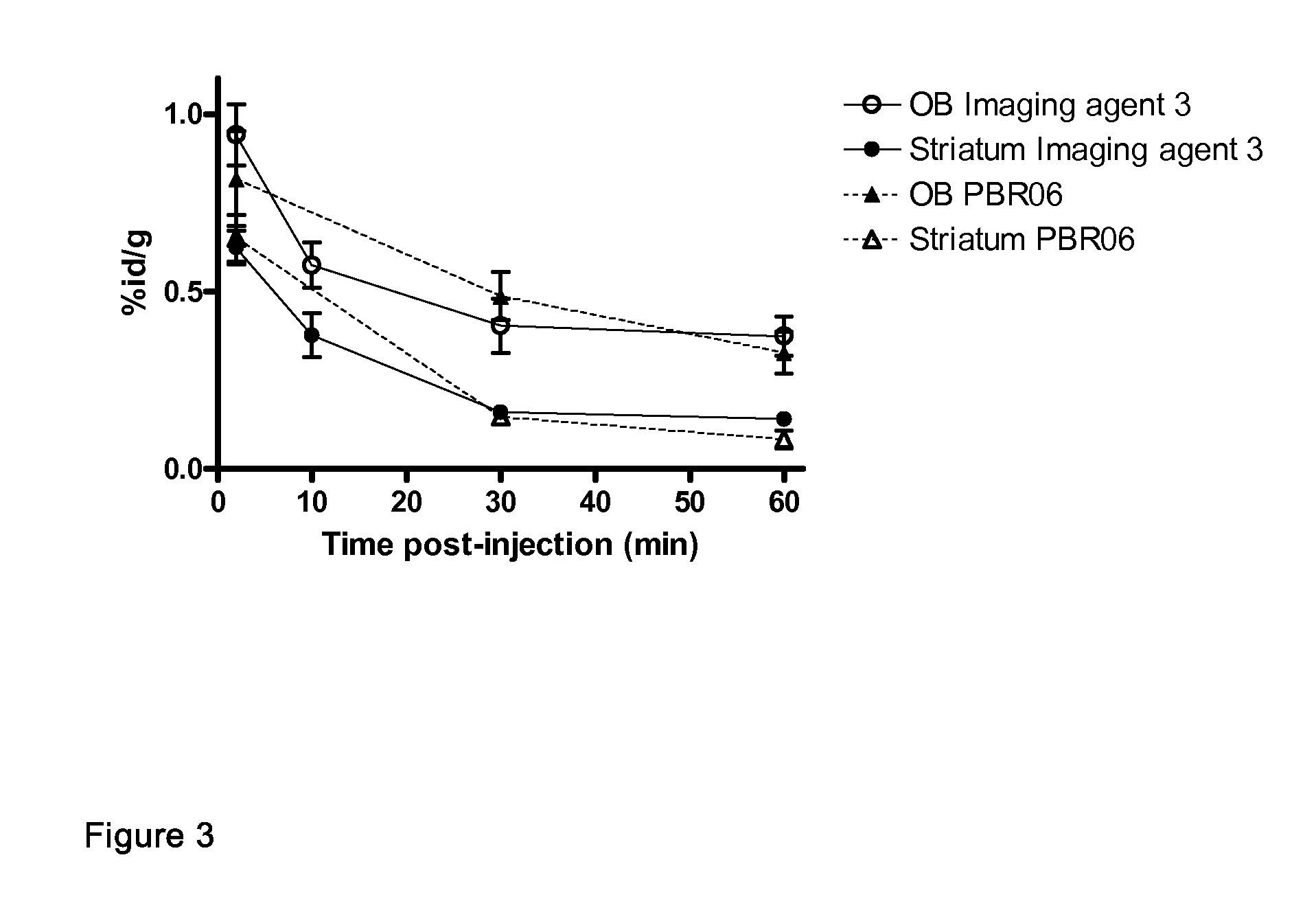Aryloxyanilide imaging agents
- Summary
- Abstract
- Description
- Claims
- Application Information
AI Technical Summary
Benefits of technology
Problems solved by technology
Method used
Image
Examples
example 1
Synthesis of the Direct Labelling Precursor for In Vivo Imaging Agent 1
Example 1(i)
2-Aminodiphenyl ether
[0085]
[0086]2-Nitrodiphenyl ether (16 g, 74 mmol) in methanol (250 ml) was shaken with palladium on charcoal (1.6 g) under an atmosphere of hydrogen at 20-50° C. for 30 min. There was a rapid uptake of hydrogen and a detectable exotherm 20-50° C. with the temperature rapidly rising before cooling. Shaking was stopped for short periods to control the temperature from rising above 50° C. The reaction was then filtered through celite and concentrated in high vacuum to give 2-aminodiphenyl ether as an oil (13.5 g, 72.9 mmole, 98%) that crystallized on standing to give a buff solid.
[0087]1H NMR (CDCl3) 300 MHz δ 3.82 (2H, brm, NH2), 6.7-7.1 (7H, m, ArH) 7.33 (2H, m, ArH).
[0088]13C NMR (CDCl3) 75 MHz δ116.41, 117.03, 118.70 (2C), 120.22, 122.57, 124.85, 129.65 (2C), 138.70, 142.97, 157.43.
Example 1(ii)
N-(2,3-Dihydro-benzofuran-7-ylmethyl)-N-(2-phenoxyphenyl)-amine
[0089]
[0090]2-Aminodiph...
example 1 (
Example 1(iii)
2-Bromo-N-(2,3-dihydrofuran-7-ylmethyl)-N-(2-phenoxyphenyl)-acetamide
[0093]
[0094]N-(2,3-Dihydrobenzofuran-7-ylmethyl)-N-(2-phenoxyphenyl)amine (0.5 g, 1.57 mmol) in dichloromethane (10 ml) was cooled to 0° C. and treated with bromoacetyl chloride (272 mg, 1.73 mmol) and triethylamine (175 mg, 1.73 mmol) and stirred for 1 h under an atmosphere of nitrogen. The reaction was diluted with dichloromethane (50 ml) and washed with 5N hydrochloric acid (20 ml) to remove the triethylamine and aqueous potassium carbonate (20 ml) to remove excess bromoacetyl chloride. The organic layer was separated, dried over magnesium sulphate and concentrated in high vacuum to give 2-bromo-N-(2,3-dihydrofuran-7-ylmethyl)-N-(2-phenoxyphenyl)acetamide. (661 mg, 1.51 mmole, 96%).
[0095]1H NMR (CDCl3) 300 MHz, δ3.06 (2H, m, CH2Ph), 3.8 (2H, d, d CH2O), 4.2-4.4 (2H, d, q, CH2Br) 4.7, (1H, d, CHN), 5.12, (1H, d, CHN), 6.62-7.32 (12H, m, ArH).
[0096]13C NMR (CDCl3) 75 MHz δ 27.81, 29.68, 46.78, 70.89,...
example 2
Synthesis of the Direct Labelling Precursor for In Vivo Imaging Agent 2
Example 2(i)
N-(benzo[1,3]dioxol-4-ylmethyl)-N-(2-phenyloxy-phenyl)amine
[0097]
[0098]A mixture of 2-phenoxy-phenylamine (410 mg, 2.22 mmol) and 2,3-(methylenedioxy)-benzaldehyde (500 mg, 3.33 mmol) was heated at 90° C. for 2 h under nitrogen. The reaction was cooled to 0° C. and MeOH (4 mL) was added, followed by NaBH4 (253 mg, 6.70 mmol) in portions over 20 min. The mixture was stirred at room temperature for 24 h. Formic acid (0.4 mL was added and the mixture stirred for 15 min. The solvents were removed in vacuo, the residue quenched with saturated aqueous NaHCO3 (50 mL), extracted with DCM (2×30 mL), dried over MgSO4, filtered and solvents removed in vacuo. The crude material was purified by silica gel chromatography eluting with petroleum spirit (A) and ethyl acetate (B) (5% B, 80 g, 4.0 CV, 60 mL / min) to afford 360 mg (51%) of N-(benzo[1,3]dioxol-4-ylmethyl)-N-(2-phenyloxy-phenyl) amine as a white solid.
[0099...
PUM
| Property | Measurement | Unit |
|---|---|---|
| Capacitance | aaaaa | aaaaa |
| Biocompatibility | aaaaa | aaaaa |
| Distribution | aaaaa | aaaaa |
Abstract
Description
Claims
Application Information
 Login to View More
Login to View More - R&D
- Intellectual Property
- Life Sciences
- Materials
- Tech Scout
- Unparalleled Data Quality
- Higher Quality Content
- 60% Fewer Hallucinations
Browse by: Latest US Patents, China's latest patents, Technical Efficacy Thesaurus, Application Domain, Technology Topic, Popular Technical Reports.
© 2025 PatSnap. All rights reserved.Legal|Privacy policy|Modern Slavery Act Transparency Statement|Sitemap|About US| Contact US: help@patsnap.com



